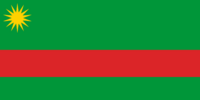Khirmania: Difference between revisions
Khirmenistan (talk | contribs) No edit summary |
Khirmenistan (talk | contribs) No edit summary |
||
| Line 28: | Line 28: | ||
}} | }} | ||
Khirmania, officially the Holy State of Khirmania, is a sovereign nation located in Thrismari and is bordered by [[Salamat]] to the southwest and [[Ouardania]] to the north. | |||
| Line 62: | Line 62: | ||
==Military== | ==Military== | ||
Khirmania's armed forces consist of 2 branches: the Army, and the Air Force. All Khirmeni citizens aged 18-20 are required to serve in the military for a 1-year period. | |||
=Economy= | =Economy= | ||
Khirmania is a upper middle developing mixed economy. For most of its history, the nation was mostly an agrarian society. It experienced rapid economic and industrial growth that started in the early 1960s up until the start of the [[Salamati-Khirmanian war]]. | |||
==Energy== | ==Energy== | ||
Revision as of 12:32, 21 February 2024
The Holy State of Khirmania | |
|---|---|
|
Flag | |
| Capital | Mukarda |
| Official languages | Khirmani, Common |
| Ethnic groups |
|
| Religion |
|
| Demonym(s) | Khirmanian |
| Government | Unitary theocratic semi-absolute monarchy |
• Lakan | Duwo II |
| Population | |
• 2022 estimate | 18.7 million |
| Currency | Khirmanian Dollar |
Khirmania, officially the Holy State of Khirmania, is a sovereign nation located in Thrismari and is bordered by Salamat to the southwest and Ouardania to the north.
History
Pre-history
13th century to Riamese colonisation
The Great War
Independent Nation and Mamud Khadir
21st Century
Geography
Climate
Biodiversity
Government and Politics
Lakan
The Lakan is the head of state and highest religious official of Khirmania who holds absolute power.
Parliament
The Khirmanian Parliament is the unicameral legislative branch of the Government of Khirmania. Members of parliament are alected to a 5 year term.
Military
Khirmania's armed forces consist of 2 branches: the Army, and the Air Force. All Khirmeni citizens aged 18-20 are required to serve in the military for a 1-year period.
Economy
Khirmania is a upper middle developing mixed economy. For most of its history, the nation was mostly an agrarian society. It experienced rapid economic and industrial growth that started in the early 1960s up until the start of the Salamati-Khirmanian war.
Energy
Tourism
Infrastructure
Transportation
Rail transport is the dominant mode of transportation in the country.
